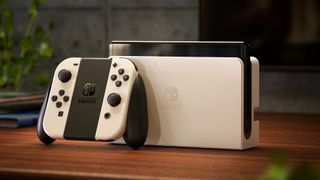If the Nintendo Switch OLED can't do it, we'll upscale for ourselves
Could third-party accessories do what Nintendo refuses to?

The Nintendo Switch OLED marked a pleasing refresh of the Switch family of consoles, packing in a flashy OLED panel, improved speakers, an Ethernet connector, and a host of other (minor) enhancements. But when it comes to the matter of upscaling, you may need to look elsewhere.
Our peers at Tom's Guide have tested out a third-party accessory known as the mClassic, which retails for $79 at Amazon. It's essentially an HDMI converter, connecting the HDMI port in your Switch and the HDMI cable running to your 4K TV. (Despite the 'm' logo, no, there is no affiliation with McDonald's.)
The problem with the Nintendo Switch or Switch OLED is that neither offer built-in upscaling before outputting to a television display. If you're using a 4K TV for gaming – as many do – you're simply not making the most of all those pixels, and the picture can suffer because of it.
Rumors have abounded of a Switch Pro or Switch 4K model that would be able to upscale Switch games to Ultra HD before showing on a TV screen – in a similar way to the Xbox Series S – and it meant many were disappointed when the latest Switch refresh offered an improved handheld experience but nothing for those who play docked most of the time.
The mClassic, however, can connect to any device with an HDMI port and outgoing video, adding anti-aliasing to help smoothen images and up the general quality of the output.
Too little, too late?
The mClassic is a limited piece of hardware – as Tom's Guide writer Imad Khan puts it, "The mClassic only bumps the resolution to the next output value. This means that a 720p signal can only go up to 1080p. A 1080p signal can only go up to 1440p. The mClassic doesn't magically post-process an image from 720p to 4K. Doing so would likely require much more horsepower and special upscaling algorithms."
It's the kind of functionality we'd love to see built into a Switch console itself, but which may be a long way off. New Switch consoles have launched at roughly two-year intervals, and that makes it likely that a Switch 4K / Switch Pro won't appear before late 2023, if not after.
Get daily insight, inspiration and deals in your inbox
Get the hottest deals available in your inbox plus news, reviews, opinion, analysis and more from the TechRadar team.
While the mClassic only offers a mild improvement, the difference will no doubt be felt in a long play session on a big-screen gaming TV, reducing irritation at the picture compromises needed to keep even an AAA Switch game running at a good frame rate. And as long as Nintendo doesn't offer first-party solutions, or update aging Switch hardware in good time, players are going to have to look elsewhere.
Bring on the Nintendo Switch accessories, official or not!
- Nintendo Switch OLED vs Nintendo Switch: what's the difference?
Henry is a freelance technology journalist, and former News & Features Editor for TechRadar, where he specialized in home entertainment gadgets such as TVs, projectors, soundbars, and smart speakers. Other bylines include Edge, T3, iMore, GamesRadar, NBC News, Healthline, and The Times.
Most Popular



